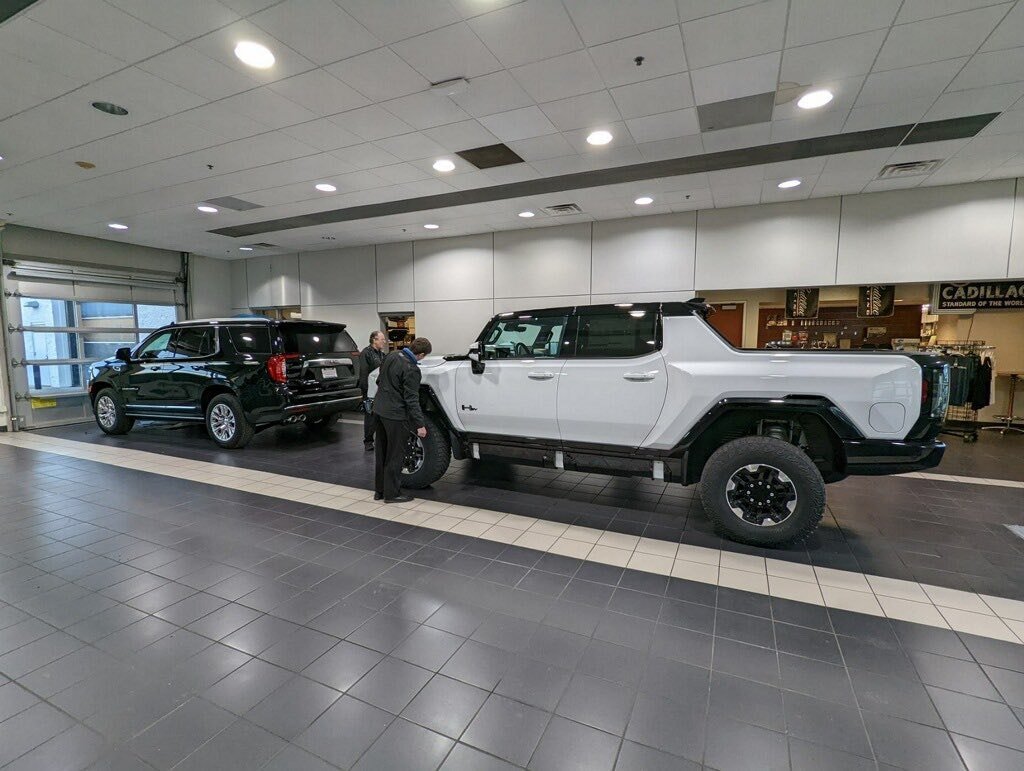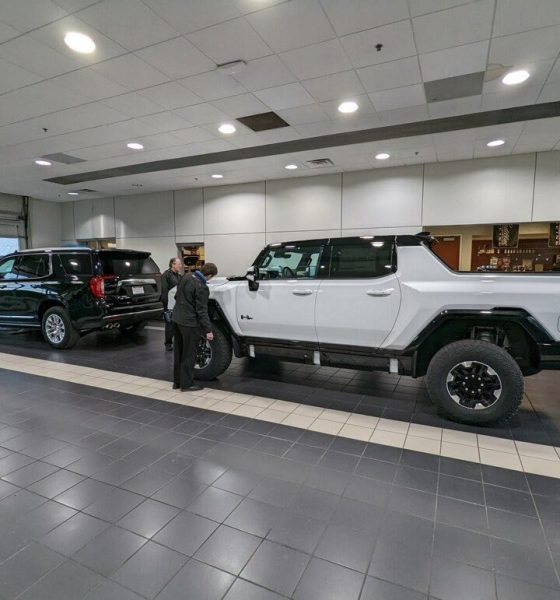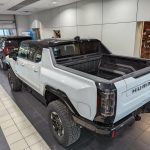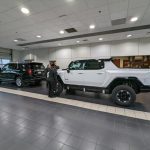

News
GMC Hummer EV sports its massive size alongside full-size SUV
The GMC Hummer EV is finally making its way to dealerships on the East Coast, sporting its massive size as it sits alongside a GMC Yukon, one of the automaker’s largest sport utility vehicles.
After being in development for several years, the GMC Hummer EV is finally making its way to dealerships on the East Coast.
New photographs of the Hummer EV landed on the HummerChat forums earlier this week. In late December, GMC announced the Hummer EV would make its way from the Factory Zero facility in Hamtramck, Michigan to customers, finally completing the first deliveries of the notorious gas-hog name turned sustainable.
However, since the announcement, the GMC Hummer EV has been tough to spot. While the massive vehicle sports some of GM’s most revolutionary and advanced systems, including its Ultium battery system, it appears details on the initial builds are relatively slim. After all, the Hummer EV was actually GM’s second-most-produced electric vehicle in December 2021. The automaker has dealt with widespread battery issues with its Chevrolet Bolt EV, which has been its keystone EV for a decade. During the month, GM produced 26 total electric units: one HUMMER EV, and twenty-five Chevrolet Bolt EVs.
Nevertheless, the Biden-proclaimed “Leader of EVs” is definitely making slow-but-steady progress on its EV front. The Hummer EV is actually the second all-electric pickup to make it to the consumer market, following only the Rivian R1T, which reportedly had its production rate increased by 300 percent in the past week.
In a GMC showroom in North Carolina, the Hummer EV sits just behind a GMC Yukon, an SUV with a notoriously large size. The Yukon comes in several sizes, and we’re not sure if this is the largest trim package. However, the Hummer EV appears to be considerably larger than the Yukon, which puts the all-electric pickup’s massive size into perspective.
- Credit: @Benji_OOS | Hummer EV Page on Facebook
- Credit: @Benji_OOS | Hummer EV Page on Facebook
Of course, the original Hummer vehicles were massive themselves. The original Hummer H1 had a 130-inch wheelbase, but the EV version even outsizes that with its 135.6-inch wheelbase. For comparison’s sake, the 2022 GMC Yukon has a 120.9-inch wheelbase.
Interestingly, the large exterior shell of the Hummer EV does not necessarily guarantee massive amounts of interior cargo space. Unfortunately, the Hummer EV’s interior room tops out at 81.8 cubic feet, which makes it slightly larger than the 76.2 cubic feet the Tesla Model Y offers with its seats folded down. The Tesla Model Y is not a pickup, however, and is a crossover SUV. Of course, these measurements do not take into account the additional storage space in the bed, which is 60 inches long. The Ford F-150 Lightning will have a 67.1-inch bed, for comparison.
- Credit: @Benji_OOS | Hummer EV Page on Facebook
- Credit: @Benji_OOS | Hummer EV Page on Facebook
The GMC Hummer EV features several incredible features that GM has gloated in the buildup to the vehicle’s release:
- 4 Wheel Steer featuring CrabWalk – allows the rear wheels and front wheels to steer at the same angle at low speeds, enabling diagonal movement of the vehicle, for even greater maneuverability on challenging terrain.
- Adaptive Air Suspension with Extract Mode – enables the suspension height to be raised approximately 6 inches (149 mm) to help the GMC HUMMER EV negotiate extreme off-road situations such as clearing boulders or fording water.
- Watts to Freedom – a driver-selectable experience that unleashes the full acceleration capability of the EV propulsion system, including GM-estimated 0-60-mph performance in approximately 3 seconds.
- Super Cruise – a driver-assistance feature offering hands-free driving on more than 200,000 miles (approximately 322,000 km) of enabled roads, and a new automatic lane changing feature, where the system can determine when a lane change is optimal and initiate the maneuver while following signaling protocols.
The Hummer EV is still available to order and costs $110,295.
I’d love to hear from you! If you have any comments, concerns, or questions, please email me at joey@teslarati.com. You can also reach me on Twitter @KlenderJoey, or if you have news tips, you can email us at tips@teslarati.com.

Elon Musk
Elon Musk and Tesla AI Director share insights after empty driver seat Robotaxi rides
The executives’ unoccupied tests hint at the rapid progress of Tesla’s unsupervised Robotaxi efforts.

Tesla CEO Elon Musk and AI Director Ashok Elluswamy celebrated Christmas Eve by sharing personal experiences with Robotaxi vehicles that had no safety monitor or occupant in the driver’s seat. Musk described the system’s “perfect driving” around Austin, while Elluswamy posted video from the back seat, calling it “an amazing experience.”
The executives’ unoccupied tests hint at the rapid progress of Tesla’s unsupervised Robotaxi efforts.
Elon and Ashok’s firsthand Robotaxi insights
Prior to Musk and the Tesla AI Director’s posts, sightings of unmanned Teslas navigating public roads were widely shared on social media. One such vehicle was spotted in Austin, Texas, which Elon Musk acknowleged by stating that “Testing is underway with no occupants in the car.”
Based on his Christmas Eve post, Musk seemed to have tested an unmanned Tesla himself. “A Tesla with no safety monitor in the car and me sitting in the passenger seat took me all around Austin on Sunday with perfect driving,” Musk wrote in his post.
Elluswamy responded with a 2-minute video showing himself in the rear of an unmanned Tesla. The video featured the vehicle’s empty front seats, as well as its smooth handling through real-world traffic. He captioned his video with the words, “It’s an amazing experience!”
Towards Unsupervised operations
During an xAI Hackathon earlier this month, Elon Musk mentioned that Tesla owed be removing Safety Monitors from its Robotaxis in Austin in just three weeks. “Unsupervised is pretty much solved at this point. So there will be Tesla Robotaxis operating in Austin with no one in them. Not even anyone in the passenger seat in about three weeks,” he said. Musk echoed similar estimates at the 2025 Annual Shareholder Meeting and the Q3 2025 earnings call.
Considering the insights that were posted Musk and Elluswamy, it does appear that Tesla is working hard towards operating its Robotaxis with no safety monitors. This is quite impressive considering that the service was launched just earlier this year.
Elon Musk
Starlink passes 9 million active customers just weeks after hitting 8 million
The milestone highlights the accelerating growth of Starlink, which has now been adding over 20,000 new users per day.

SpaceX’s Starlink satellite internet service has continued its rapid global expansion, surpassing 9 million active customers just weeks after crossing the 8 million mark.
The milestone highlights the accelerating growth of Starlink, which has now been adding over 20,000 new users per day.
9 million customers
In a post on X, SpaceX stated that Starlink now serves over 9 million active users across 155 countries, territories, and markets. The company reached 8 million customers in early November, meaning it added roughly 1 million subscribers in under seven weeks, or about 21,275 new users on average per day.
“Starlink is connecting more than 9M active customers with high-speed internet across 155 countries, territories, and many other markets,” Starlink wrote in a post on its official X account. SpaceX President Gwynne Shotwell also celebrated the milestone on X. “A huge thank you to all of our customers and congrats to the Starlink team for such an incredible product,” she wrote.
That growth rate reflects both rising demand for broadband in underserved regions and Starlink’s expanding satellite constellation, which now includes more than 9,000 low-Earth-orbit satellites designed to deliver high-speed, low-latency internet worldwide.
Starlink’s momentum
Starlink’s momentum has been building up. SpaceX reported 4.6 million Starlink customers in December 2024, followed by 7 million by August 2025, and 8 million customers in November. Independent data also suggests Starlink usage is rising sharply, with Cloudflare reporting that global web traffic from Starlink users more than doubled in 2025, as noted in an Insider report.
Starlink’s momentum is increasingly tied to SpaceX’s broader financial outlook. Elon Musk has said the satellite network is “by far” the company’s largest revenue driver, and reports suggest SpaceX may be positioning itself for an initial public offering as soon as next year, with valuations estimated as high as $1.5 trillion. Musk has also suggested in the past that Starlink could have its own IPO in the future.
News
NVIDIA Director of Robotics: Tesla FSD v14 is the first AI to pass the “Physical Turing Test”
After testing FSD v14, Fan stated that his experience with FSD felt magical at first, but it soon started to feel like a routine.

NVIDIA Director of Robotics Jim Fan has praised Tesla’s Full Self-Driving (Supervised) v14 as the first AI to pass what he described as a “Physical Turing Test.”
After testing FSD v14, Fan stated that his experience with FSD felt magical at first, but it soon started to feel like a routine. And just like smartphones today, removing it now would “actively hurt.”
Jim Fan’s hands-on FSD v14 impressions
Fan, a leading researcher in embodied AI who is currently solving Physical AI at NVIDIA and spearheading the company’s Project GR00T initiative, noted that he actually was late to the Tesla game. He was, however, one of the first to try out FSD v14.
“I was very late to own a Tesla but among the earliest to try out FSD v14. It’s perhaps the first time I experience an AI that passes the Physical Turing Test: after a long day at work, you press a button, lay back, and couldn’t tell if a neural net or a human drove you home,” Fan wrote in a post on X.
Fan added: “Despite knowing exactly how robot learning works, I still find it magical watching the steering wheel turn by itself. First it feels surreal, next it becomes routine. Then, like the smartphone, taking it away actively hurts. This is how humanity gets rewired and glued to god-like technologies.”
The Physical Turing Test
The original Turing Test was conceived by Alan Turing in 1950, and it was aimed at determining if a machine could exhibit behavior that is equivalent to or indistinguishable from a human. By focusing on text-based conversations, the original Turing Test set a high bar for natural language processing and machine learning.
This test has been passed by today’s large language models. However, the capability to converse in a humanlike manner is a completely different challenge from performing real-world problem-solving or physical interactions. Thus, Fan introduced the Physical Turing Test, which challenges AI systems to demonstrate intelligence through physical actions.
Based on Fan’s comments, Tesla has demonstrated these intelligent physical actions with FSD v14. Elon Musk agreed with the NVIDIA executive, stating in a post on X that with FSD v14, “you can sense the sentience maturing.” Musk also praised Tesla AI, calling it the best “real-world AI” today.












